How to Identify Stress in Farmed Fish: A Comprehensive Guide
Farmed fish are easily affected by stress, which harms their health and growth. This guide explains the causes, signs, and prevention methods of fish stress in simple terms, helping farmers maintain healthy fish and improve production.
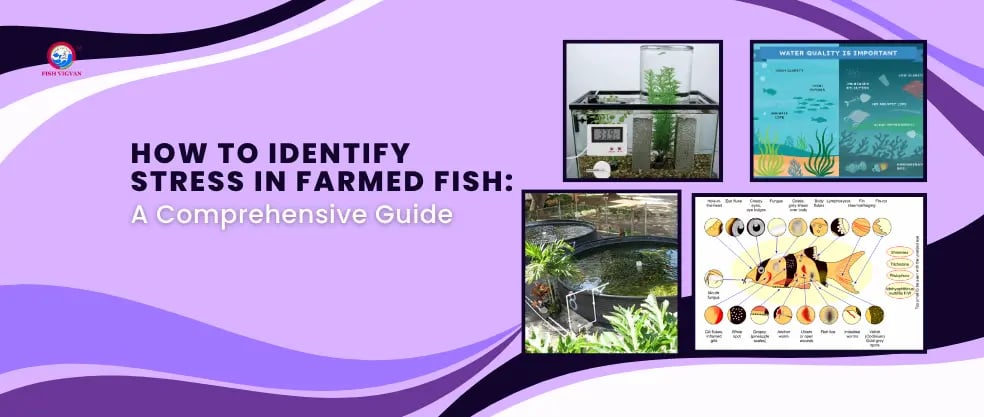

How to Identify Stress in Farmed Fish: A Comprehensive Guide
Farmed fish, like all animals, are susceptible to stress, which can compromise their health, stunt their growth, and lead to significant losses in aquaculture operations. Early detection and management of stress are vital for fish farmers aiming to maintain a thriving, sustainable, and profitable farm. Stress in fish can arise from various environmental, biological, and operational factors, but with proper knowledge and tools, farmers can mitigate these risks effectively.
At Fish Vigyan, we are dedicated to empowering fish farmers through expert training, consultancy, and high-quality aquaculture equipment. Our mission is to help you achieve optimal fish health and maximize yields. In this detailed guide, we will explore the causes of stress in farmed fish, key indicators to watch for, and actionable strategies to prevent and manage stress. By implementing these best practices, you can ensure a stress-free environment for your fish, leading to healthier stocks and a more successful farm.
What Causes Stress in Farmed Fish?
Stress in aquaculture is a complex issue influenced by multiple factors. The Fish Vigyan highlights that stress in fish can be triggered by environmental conditions, biological challenges, and farm management practices. Understanding these stressors is the first step toward creating a healthy aquatic environment. Below, we delve into the primary causes of stress in farmed fish.
1. Poor Water Quality
Water is the lifeblood of any aquaculture system, and its quality directly impacts fish health. Fish are highly sensitive to changes in their aquatic environment, and poor water quality is one of the leading causes of stress. Key water quality stressors include:
Low Dissolved Oxygen (Hypoxia): Fish rely on oxygen dissolved in water to breathe. Levels below 5 mg/L can cause respiratory distress, reduced growth, and even mortality.
High Ammonia or Nitrite Levels: These toxic compounds accumulate from fish waste and uneaten feed. Ammonia levels above 0.02 mg/L can damage gills and impair oxygen uptake.
Extreme pH Fluctuations: Most fish thrive in a pH range of 6.5–8.5, depending on the species. Sudden shifts outside this range can disrupt metabolic processes.
Salinity Changes: For species like tilapia or salmon, abrupt changes in salinity can cause osmotic stress, leading to dehydration or overhydration.
Regular monitoring and maintenance of water quality are critical. Fish Vigyan offers advanced water testing kits and consultancy services to help farmers maintain optimal conditions for their fish.
2. Overcrowding
High stocking densities is a common practice to maximize production, but it often leads to stress. Overcrowding results in:
Increased Aggression: Fish compete for space, leading to injuries and fin damage.
Higher Disease Transmission: Close proximity facilitates the spread of pathogens and parasites.
Competition for Resources: Limited access to food and oxygen can weaken fish and reduce growth rates.
Farmers must adhere to species-specific stocking densities guidelines to prevent these issues. Fish Vigyan provides tailored consultancy to help you calculate the ideal stocking density for your farm based on pond size, species, and system type.
3. Temperature Fluctuations
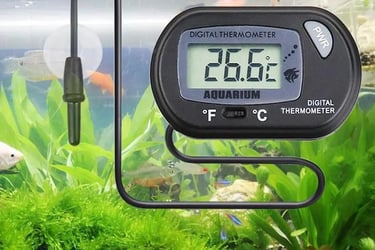

As ectothermic (cold-blooded) animals, fish cannot regulate their body temperature and are highly sensitive to environmental changes. Sudden or extreme temperature shifts can cause:
Metabolic Slowdown: Cold temperatures reduce metabolic rates, leading to lethargy and decreased appetite.
Reduced Immunity: Temperature stress weakens the immune system, making fish more susceptible to diseases.
Thermal Shock: Rapid changes, such as those caused by adding cold water to a warm pond, can be fatal.
Maintaining stable temperatures through proper pond design and aeration systems is essential. Fish Vigyan supplies energy-efficient aerators and temperature monitoring tools to ensure a stable aquatic environment.
4. Poor Nutrition
A balanced diet is crucial for fish health and stress resilience. Poor nutrition can lead to:
Malnutrition: Deficiencies in essential nutrients like proteins, vitamins, or minerals weaken fish.
Weakened Immunity: Inadequate diets reduce the ability to fight infections.
Stunted Growth: Chronic underfeeding or low-quality feed hampers development.
Farmers should invest in high-quality, species-specific feed and follow proper feeding schedules. Fish Vigyan offers training programs that educate farmers on nutritional requirements and feed management to optimize fish growth and health.
5. Handling and Transport
Physical handling during netting, grading, or transportation is inherently stressful for fish. Common issues include:
Physical Injuries: Rough handling can cause scale loss, fin tears, or skin abrasions, increasing infection risk.
Elevated Cortisol Levels: Stress triggers the release, which suppresses the immune system.
Oxygen Depletion: Poorly managed transport tanks can lead to hypoxia.
Minimizing handling and ensuring gentle techniques are key. Fish Vigyan provides specialized equipment, such as soft nets and oxygenated transport systems, to reduce stress during these processes.
6. Disease and Parasites
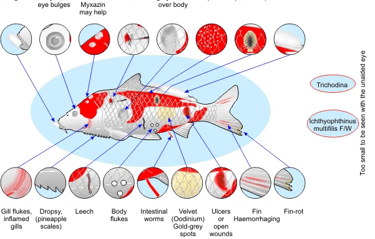

Infections from bacteria, viral, or parasitic organisms can both cause and amplify stress. Common issues include:
Bacterial Infections: Such as Aeromonas or Vibrio, which cause ulcers and fin rot.
Parasites: Like Ichthyophthirius (white spot disease), which irritate skin and gills.
Viral Diseases: Such as viral hemorrhagic septicemia (VHS), which can devastate fish populations.
Preventive measures like quarantine and biosecurity are critical. **Fish Vigyan’s consultancy services include disease management protocols to safeguard your farm.
Key Signs of Stress in Farmed Fish
Recognizing stress early can prevent minor issues from escalating into catastrophic losses. Stress in fish manifests through behavioural changes, physical symptoms, and physiological changes, and growth-related indicators. Below are the key signs to monitor:
1. Behavioural Changes
Changes in fish behaviour are often the earliest indicators of stress:
Erratic Swimming: Fish may exhibit darting, spiralling, or lethargic movements, indicating discomfort or oxygen Gasping. at the Surface: This suggests low oxygen levels or gill damage.
Reduced Feeding: A sudden drop in appetite signals stress or illness.
Aggression or Hiding: Overcrowding or poor water quality can cause increased aggression or withdrawal.
Regular observation of fish behaviour is crucial. Fish Vigyan offers training on behavioural analysis to help farmers detect stress early.
2. Physical Symptoms
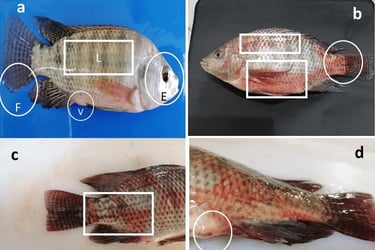

Visible physical changes often accompany stress:
Colour Changes: Faded or darkened coloration indicates stress or poor health.
Fin Clamping: Fish hold their fins close to the body, reducing mobility.
Skin Issues: Red streaks, ulcers, or excessive mucus suggest infections or water quality problems.
Gill Damage: Swollen or discoloured gills indicate respiratory stress.
3. Physiological Signs
Internal changes may require closer inspection:
Rapid Breathing: Increased gill movement suggests low oxygen or toxic exposure.
Swollen Abdomen or Eyes: These can indicate bacterial infections or parasitic infestations.
Weight Loss: Persistent weight loss despite feeding signals chronic stress.
4. Poor Growth and Mortality
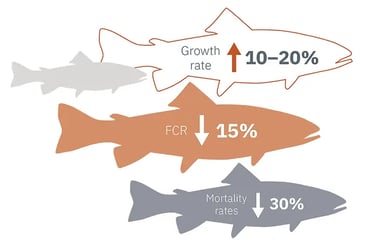

Chronic stress has long-term consequences:
Stunted Growth: Stress diverts energy from growth to survival.
Reduced Reproduction: Stress impairs reproductive success, affecting future stock.
Sudden Die-Offs: Unmanaged stress can lead to mass mortality events.
Monitoring growth rates and mortality is essential for early intervention. Fish Vigyan provides tools and training for accurate record-keeping and analysis.
How to Prevent and Manage Stress in Farmed Fish
Preventing stress requires a proactive approach that combines good management practices, regular monitoring, and the right equipment. Below are actionable strategies to keep your fish healthy and stress-free.
1. Maintain Optimal Water Quality
Water quality is the foundation of fish health. Key steps include:
Monitor Oxygen Levels: Keep dissolved oxygen above 5 mg/L using aerators.
Test Toxins: Regularly check ammonia (<0.02 mg/L), nitrite, and nitrate levels.
Control pH: Maintain a stable pH within the species-specific range.
Water Changes: Perform partial water changes to dilute toxins and refresh the environment.
Fish Vigyan offers advanced water quality testing kits and automated monitoring systems to simplify this process.
2. Avoid Overcrowding
Follow species-specific stocking density guidelines to prevent competition and aggression. Regularly assess pond capacity and adjust stocking as fish grow. Fish Vigyan provides consultancy to optimize stocking strategies for maximum productivity without compromising health.
3. Provide High-Quality Feed
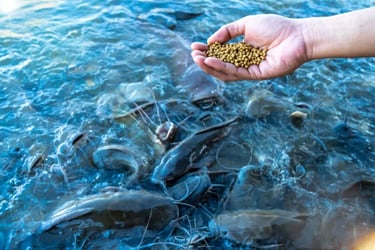

Nutrition is a cornerstone of stress prevention:
Use Balanced Feed: Choose feed tailored to the species’ nutritional needs.
Follow Feeding Schedules: Avoid overfeeding, which pollutes water, or underfeeding, which weakens fish.
Store Feed Properly: Prevent Mold and nutrient degradation by storing feed in cool, dry conditions.
Fish Vigyan offers training on feed management and partners with trusted feed suppliers to ensure quality.
4. Minimize Handling Stress
Gentle handling reduces physical and physiological stress:
Use Soft Nets: Minimize scale loss and injuries with specialized nets.
Limit Handling: Avoid unnecessary netting or grading.
Acclimate Fish: Gradually introduce fish to new environments to prevent shock.
Fish Vigyan supplies handling equipment designed to minimize stress and injury.
5. Implement Disease Prevention Measures
A robust biosecurity plan prevents disease-related stress:
Quarantine New Stock: Isolate new fish for 2–4 weeks to prevent pathogen introduction.
Disinfect Equipment: Regularly clean nets, tanks, and tools.
Vaccinate When Possible: Use vaccines for species like salmon or trout where available.
Fish Vigyan offers biosecurity training and disinfection protocols to protect your farm.
6. Use Stress-Reducing Supplements
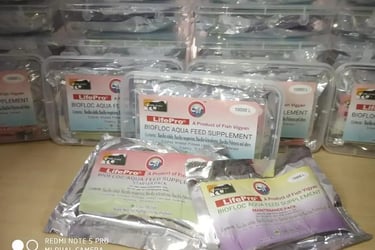

Supplements can enhance fish resilience:
Vitamin C: Boosts immunity and aids recovery from stress.
Probiotics: Improve gut health and nutrient absorption.
Electrolytes: Help fish maintain osmotic balance during transport or stress events.
Fish Vigyan provides guidance on supplement use to optimize fish health.
Best Practices for a Stress-Free Fish Farm
Creating a stress-free environment requires consistent effort and attention to detail. Below are best practices to ensure long-term success:
Regular Monitoring: Check water parameters, fish behaviour, and growth rates daily. Use automated systems for real-time data.
Proper Aeration: Install energy-efficient aerators to maintain oxygen levels, especially in warm weather.
Gradual Changes: Avoid sudden shifts in temperature, salinity, or water chemistry.
Staff Training: Equip your team with knowledge on fish handling, water management, and stress detection. Fish Vigyan offers comprehensive training programs tailored to your needs.
Emergency Preparedness: Have backup power for aeration systems and a response plan for disease outbreaks or environmental changes.
Record-Keeping: Maintain detailed records of water quality, feed usage, and fish health to identify trends and address issues early.
Conclusion
Stress in farmed fish is a manageable challenge with the right knowledge, tools, and practices. By maintaining optimal water quality, providing balanced nutrition, minimizing handling, and implementing robust biosecurity measures, you can create a healthy, productive aquaculture operation. Early detection of stress through behavioural, physical, and physiological signs is key to preventing losses and ensuring long-term success.
At Fish Vigyan, we are committed to supporting fish farmers with expert training, consultancy, and cutting-edge equipment. Whether you’re a beginner or an experienced farmer, our resources can help you optimize your farm and achieve sustainable growth. Contact Fish Vigyan today to learn how we can help you build a stress-free, thriving fish farm.
